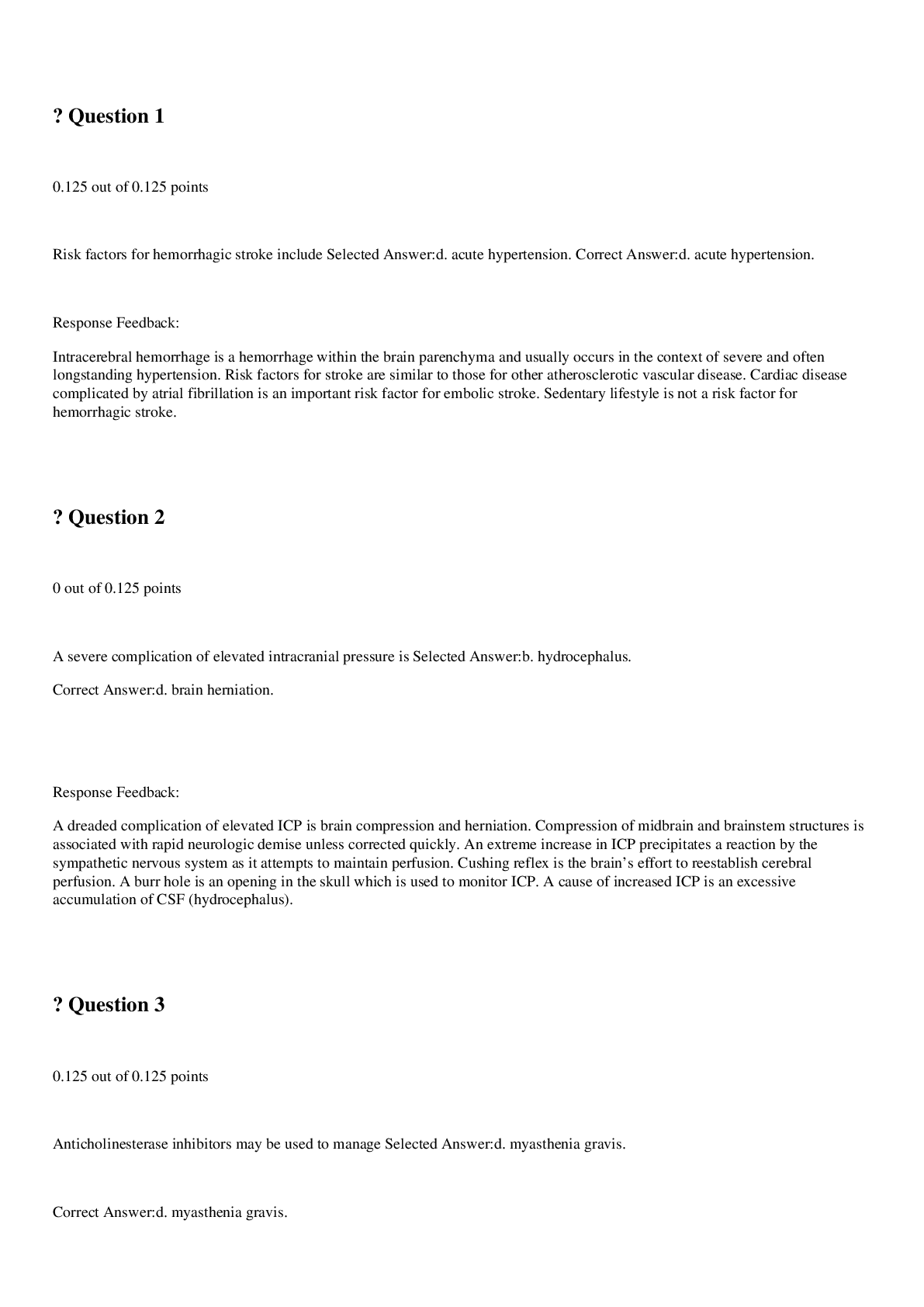 With ALL correct Answers (Actual Test 100 Satisfied).png)
AHIP - Final Examination (Latest Update 2022) Questions And Answers( With Complete top Solution Rated A)
Pathophysiology > EXAM > PATHO 370 TEST 6 - Questions, Answers and Response Feedback (All)
• Question 1 0.125 out of 0.125 points The finding of hypotension, rigid abdomen, and absent bowel sounds in a patient with pancreatitis Selected Answer: a. indicates peritonitis with ... substantial risk for sepsis and shock. Correct Answer: a. indicates peritonitis with substantial risk for sepsis and shock. Response Feedback: In acute pancreatitis, fever is common but is usually low-grade initially. In more severe pancreatitis, hypotension, rigid abdomen, and absent bowel sounds are present. Hypotension, rigid abdomen, and absent bowel sounds are unexpected findings. Pancreatic surgery is technically challenging and risky, and generally is only considered as a last resort. Findings indicative of peritonitis do occur and should be treated promptly. • Question 2 0.125 out of 0.125 points Narcotic administration should be administered carefully in patients with acute pancreatitis related to potential for Selected Answer: b. sphincter of Oddi dysfunction. Correct Answer: b. sphincter of Oddi dysfunction. Response Feedback: All narcotics should be used carefully because of the potential of sphincter of Oddi dysfunction, although recent studies show that no single agent is contraindicated. Respiratory failure related to adult respiratory distress syndrome is a risk factor with severe pancreatitis. Narcotic dependency should not be a concern with acute pancreatitis. While patients should always be assessed for allergies, this is not the primary concern. • Question 3 0.125 out of 0.125 points Celiac sprue is a malabsorptive disorder associated with Selected Answer: a. inflammatory reaction to gluten-containing foods. Correct Answer: a. inflammatory reaction to gluten-containing foods. Response Feedback: Celiac disease (also called celiac sprue) is characterized by intolerance of gluten, a protein in wheat and wheat products. Current research suggests that celiac sprue is an immune disorder. The main pathologic finding is villus atrophy, with a decrease in the activity and amount of surface epithelial enzymes. Celiac sprue is not associated with ulceration of the distal colon and rectum. Celiac disease is an intolerance of gluten. • Question 4 0.125 out of 0.125 points A patient reporting vision changes, photophobia, and lid lag may be exhibiting signs of Selected Answer: d. Graves disease. Correct Answer: d. Graves disease. Response Feedback: Individuals with Graves disease may have spasm and retraction of the eyelids, lid lag, and other eye complaints such as vision changes and photophobia. Changes associated with the eyes are not related to Addison disease. Cushing syndrome is not manifested by changes in the eyes. Myxedema is associated with generalized non-pitting edema. • Question 5 0.125 out of 0.125 points Dumping syndrome is commonly seen after procedures. Selected Answer: a. gastric bypass Correct Answer: a. gastric bypass Response Feedback: Dumping syndrome is a term used to describe the literal dumping of stomach contents into the proximal portion of the small intestine because of impaired gastric emptying. Interestingly, dumping seems [Show More]
Last updated: 2 years ago
Preview 1 out of 16 pages

Buy this document to get the full access instantly
Instant Download Access after purchase
Buy NowInstant download
We Accept:


PATHO 370 PATHOPHYSIOLOGY TEST 1- TEST 7 BUNDLE - WEST COAST UNIVERSITY
By brightstudy 2 years ago
$40.5
7
Can't find what you want? Try our AI powered Search
Connected school, study & course
About the document
Uploaded On
Jan 21, 2023
Number of pages
16
Written in
All
This document has been written for:
Uploaded
Jan 21, 2023
Downloads
0
Views
98
Scholarfriends.com Online Platform by Browsegrades Inc. 651N South Broad St, Middletown DE. United States.
We're available through e-mail, Twitter, Facebook, and live chat.
FAQ
Questions? Leave a message!
Copyright © Scholarfriends · High quality services·